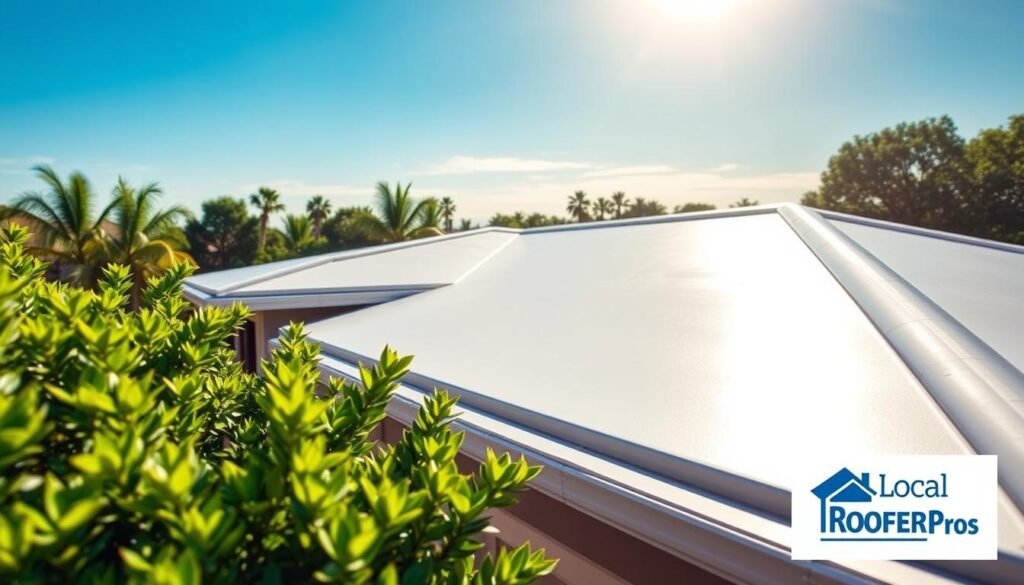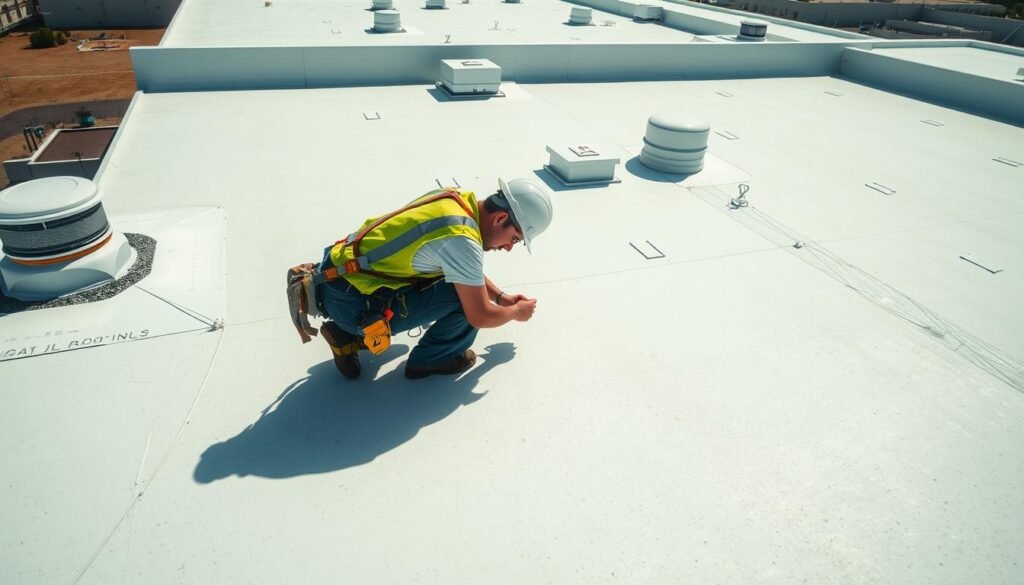Did you know TPO roofing systems now make up over 40% of the commercial roofing market in the United States? This rise in popularity is because TPO is durable, energy-efficient, and cost-effective. If you’re thinking about a TPO roof for your commercial property, this guide will help. It will walk you through the installation process for a long-lasting, high-performance roof.
TPO (thermoplastic polyolefin) is a single-ply white roofing membrane. It’s become very popular for both commercial and residential roofs. Its mix of polypropylene and ethylene-propylene rubber gives it great strength, flexibility, and weather resistance. Working with professional roofers and contractors near you ensures a proper TPO membrane installation. This will protect your building for many years.
Key Takeaways
- TPO roofing systems are increasingly popular for commercial roofing installations
- TPO offers excellent durability, energy efficiency, and cost savings
- Proper TPO membrane installation requires professional roofers and contractors
- This guide covers the step-by-step process for installing a TPO roof
- Maintenance tips are provided to extend the life of your TPO roofing system
What is TPO Roofing?
TPO (Thermoplastic Polyolefin) roofing is a top pick for flat roofs. It’s durable, saves energy, and is easy on the wallet. This single-ply membrane is made of a special layer and polyester fabric. It stands up well to punctures, tears, and UV rays.

TPO roofs are flexible and handle temperature changes well. They also fight mold, dirt, fire, and chemicals. This makes them a strong shield for your building.
Overview of TPO Material
TPO roofs come in white, grey, and tan, with white being the favorite for its cooling effect. They vary in thickness, from 45 to 80 mils. Thicker ones are more durable and resistant to damage.
Advantages of TPO Roofing
Choosing TPO roofing has many benefits:
- Durability: TPO membranes resist damage, keeping your building safe for years.
- Energy efficiency: White TPO roofs reflect sunlight and heat, cutting down on cooling costs.
- Environmentally friendly: TPO is recyclable and free from harmful chemicals, making it green.
- Cost-effective: TPO is more affordable than many other roofing options, giving you great value.
How TPO Compares to Other Roofing Types
When looking at flat roof options, it’s key to compare TPO with others:
| Roofing Type | Durability | Energy Efficiency | Cost |
|---|---|---|---|
| TPO | High | High | Moderate |
| EPDM | High | Low | Low |
| PVC | High | High | High |
| Built-Up Roofing | Moderate | Low | Low |
The table shows TPO roofing strikes a good balance. It’s durable, saves energy, and is cost-effective. This makes it a popular choice for many looking to replace or repair their flat roofs.
Preparing for TPO Roofing Installation
Before starting a TPO roofing project, it’s important to prepare well. You need to check your roof’s condition, find a good contractor, and get the right tools and materials. This preparation ensures a smooth and successful installation.
Assessing Your Current Roof Condition
First, do a detailed roof inspection. This step helps find any problems or damage before starting. Look for wear, leaks, or structural issues. Fix these to make sure your roof is ready for the new TPO membrane.

Choosing the Right Contractor
Finding a skilled and reliable roofing contractor is vital. Look for those who specialize in TPO roofing and have a good reputation. Consider their experience, licenses, customer feedback, and warranties. A good contractor ensures your TPO roof is installed right.
Necessary Tools and Materials
To install a TPO roof, you need the right tools and materials. Key items include:
| Tools | Materials |
|---|---|
| Welding equipment | TPO membrane |
| Rollers | Adhesive |
| Cutting tools | Fasteners and plates |
| Measuring tools | Insulation board |
| Safety gear | Seam tape and primer |
Make sure your roof is clean, smooth, and dry before starting. Remove any debris or sharp objects that could harm the TPO membrane. With a well-prepared roof and the right tools, you’re ready for your TPO roofing project.
Installing TPO Roofing with Local Roofer Pros
Choosing the right contractors for TPO installation is key. Local Roofer Pros, at 951-666-5881, offers top-notch TPO roofing services. Their team uses installation tips and guidelines from TPO to ensure quality results.
Step-by-Step Installation Process
The TPO roofing process starts with laying the membrane on the roof deck. Then, a special adhesive is applied to the substrate. The membrane is secured with fasteners and plates.
Seams are sealed using heat welding or tape. This makes the roof watertight. The job is finished by adding flashings and termination bars around the edges and penetrations.
Maintenance Tips for Your TPO Roof
To keep your TPO roof in good shape, regular maintenance is vital. Have your local roofer pros do inspections to catch issues early. Fix any damage quickly to avoid leaks and further damage.
Keep your roof clean to prevent ponding water. This stress can harm the membrane. By following these tips and working with Local Roofer Pros, your TPO roof will last longer and protect your building well.
